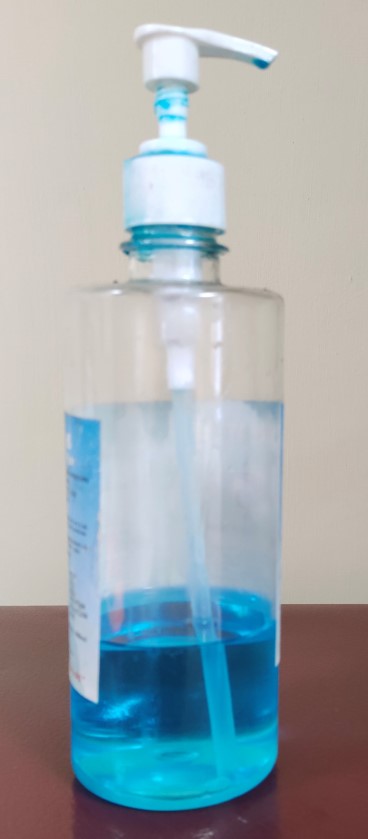
Alcohol-based hand sanitizers typically contain ethanol, isopropyl alcohol, n-propanol or a mixture of two from these. The antisepsis of alcohols is due to their protein denaturing capability. For maximum effectiveness, the alcohol solution should have a concentration between 60 to 80%. Concentration above 80% is less effective as reduced amounts of water inhibit denaturation of proteins.
.
The amount of alcohol in a sanitizer may be expressed as either of two:
• Weight percentage (m/m): Once prepared, this concentration does not change with change in temperature or other factor.
• Volume percentage (v/v): this may vary with temperature, specific gravity etc. E.g. a solution containing 70% alcohol by weight will be 76.8% by volume at 15⁰C and if the temperature in increased to 25⁰C, the volume of alcohol will increase to constitute 80.5%.
Mostly the alcohol % is expressed as volume %.
The antimicrobial activity of alcohols is due to the denaturation of proteins that it causes. Alcohols are effective against a range of gram positive and negative bacteria, including those which are multi-drug resistant as well as various fungi.
Some enveloped viruses are more susceptible to alcohols like Herpes simplex virus (HSV), HIV, influenza virus, RSV and vaccinia virus, while others are less sensitive e.g. Hepatitis B & C viruses. Nevertheless, a concentration of 60-70% can kill these too.
However they are not effective against oocysts and some non-enveloped viruses.
Therefore, they may not be an alternative to hand washing with soap and water which provided a mechanical removal effect too.
Another point is that though alcohols quickly eliminate germs on the skin, they do not provide any lasting protection. Addition of chlorhexidine, triclosan or quaternary ammonium compounds can provide lasting protection too.
Alcohols are not effective cleaners and hand washing with soap and water is still necessary when hands are dirty or contaminated with protein rich substances.
The effectiveness of alcohol based hand sanitizer is influenced by several factors, including the
• Type of alcohol used
• Its concentration
• Contact time
• Amount of alcohol solution used and
• Whether hands are wet or dry when alcohol is applied
Applying only small amounts (0.2 -0.5 ml) to the hands is no better than washing with soap and water.
The optimal volume of product for use in the hands is not clear and may also vary with the formulation.
Broadly speaking, if the hands feel dry just after 10 – 15 seconds of rubbing together, it’s likely that too little product was used.
Alcohol soaked wipes contain only a small amount of alcohol and not as effective.
Alcohol based hand rubs come in the form of low-viscosity solutions, gels, and foams. The existing data suggests that gels are slightly less effective than solutions. However, it’s important to consider that compliance is a critical factor. If a gel with lower in vitro activity is used more frequently, the overall outcome may still be better.
The frequent use of alcohol-based hand sanitizer can lead to dry skin. Addition of humectants or skin conditioning agents can alleviate this issue. For instance, glycerol of other similar agents added in1-3% concentration can minimize the drying effect of alcohol.
Studies have shown that as surgical scrubs too, alcohol based waterless are more effective, acceptable and have fewer adverse effects on skin compared to other hand hygiene products.
WHO recommends that for optimal effect, the hand rubs should be widely available at all points of care. Health care facilities may use the commercially available products if they meet the ASTM or EN standards for efficacy against microbes
WHO suggests two formulations for alcohol based hand rubs:
1.
• Ethanol 80% v/v
• Glycerol 1.45% v/v
• Hydrogen peroxide (H2O2) 0.125%
2.
• Isopropyl alcohol 75% v/v
• Glycerol 1.45% v/v
• Hydrogen peroxide (H2O2) 0.125%
Function of each ingredient:
Alcohol: Antimicrobial action. It is the active component
Hydrogen peroxide: eliminates spores that may contaminate the hand rub. In the given small concentration, It is not effective for antisepsis
Glycerol: functions as humectant. It is safe and inexpensive. Other water and alcohol miscible emollients may be used for skin care if proven that they are not toxic and allergenic.
Addition of gels may reduce the efficacy to some extent but this may be countered by increased usage.
WHO does not recommend adding fragrance as it would increase the risk of allergy
WHO-formulation hand sanitizers can be used both for hand hygiene and for surgical scrubbing.
Generally reuse of emptied bottles is not recommended as they may get contaminated with spore-forming organisms. If necessary, reusable bottles should be refilled only after they are completely emptied and then thoroughly cleaned and disinfected.
To facilitate this, the bottles should not exceed 500 ml capacity and fixed in dispensers.
Use and Precaution:
• The label should clearly mention the following:
o Composition: whether ethanol or isopropanol has been used, percentage of alcohol and other ingredients
o Manufacturing date and batch number
o For External use only
o Avoid contact with eyes
o Keep out of reach of children
• It is strictly for EXTERNAL USE
• Dispense at least a palm full amount and rub to cover every surface of hands and wrists.
• Keep rubbing the hands until they are dry
• These are flammable; keep away from flame and heat
• Use containers which are air tight to minimize evaporation which can lead to :
o Change in original composition of alcohols
o Inflammable fumes
Reference:
WHO, 2009. WHO Guidelines on Hand Hygiene in Health Care. ISBN 978 92 4 159790 6. WHO Press, World Health Organization, Geneva
